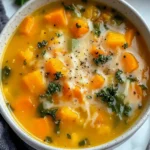This classic roast turkey is a Thanksgiving must-have, offering tender meat with a beautiful, golden-brown exterior. Basted every half hour in rich turkey stock, the turkey remains moist and flavorful throughout, making it the perfect centerpiece for your holiday table. Simple seasonings like butter, salt, and pepper let the natural flavors of the turkey shine.
Ideal for gatherings, this recipe allows you to enjoy quality time with family and friends rather than spending hours in the kitchen. With a deliciously easy preparation and stunning results, this roast turkey is sure to be a show-stopping addition to your holiday festivities.
Full Recipe:
- 1 whole turkey (18 pounds)
- 8 cups prepared stuffing
- 1/2 cup salted butter, softened
- Salt and black pepper, to taste
- 2 cups turkey stock (plus additional for basting)
Directions:
- Preheat oven to 325°F (165°C).
- Prepare the turkey by removing the neck and giblets; pat dry with paper towels. Place the turkey breast-side up on a rack inside a roasting pan.
- Fill the cavity with prepared stuffing. Rub the entire surface of the turkey with softened butter, then season generously with salt and pepper.
- Pour 2 cups of turkey stock into the roasting pan. Cover the turkey loosely with foil.
- Roast the turkey, basting with additional stock every 30 minutes, for approximately 2.5 hours.
- Remove the foil and continue roasting until a meat thermometer reads 165°F in the thickest part of the thigh (about 1.5 additional hours).
- Let the turkey rest for 20 minutes before carving.
Prep Time: 20 minutes | Cooking Time: 4 hours | Total Time: 4 hours 20 minutes
Kcal: 450 kcal per serving | Servings: 12 servings
The Ultimate Guide to Preparing a Classic Roast Turkey
Nothing quite captures the spirit of Thanksgiving and holiday gatherings like a perfectly roasted turkey. With its golden-brown, crispy skin and tender, juicy meat, a classic roast turkey is both an impressive centerpiece and a comforting tradition for family and friends. Beyond Thanksgiving, a roast turkey can also be a delicious main dish for various festive occasions, bringing warmth and togetherness to any meal. This article dives into the nuances of cooking a flawless roast turkey, offering tips, historical insights, and culinary secrets that make this dish unforgettable.
A Time-Honored Tradition: The Importance of Roast Turkey in Holiday Celebrations
Roasting a turkey dates back centuries and has become a time-honored tradition in many cultures, especially in the United States and Canada, where it takes center stage during Thanksgiving. This bird became synonymous with Thanksgiving in the U.S. largely because of its availability during the autumn harvest. Turkeys were abundant, large enough to feed multiple people, and not as economically vital as livestock, making them an ideal choice for communal feasts.
Today, the classic roast turkey represents more than just a meal—it’s a symbol of gratitude, unity, and nostalgia. The anticipation of slicing into a beautifully cooked bird, with its inviting aroma and promise of rich flavors, is enough to bring family and friends together, making it the focal point of countless memorable gatherings.
Selecting the Perfect Turkey
Choosing the right turkey is the first step toward a successful roast. Turkeys come in various types, including fresh, frozen, organic, and heritage breeds. Fresh turkeys often provide more flavor but require immediate preparation, while frozen turkeys offer convenience and a longer shelf life. For those seeking a more robust flavor, heritage turkeys are an excellent choice. These birds, raised more traditionally, have a higher muscle tone and richer taste, though they may require longer cooking times.
Size Matters: For serving a large gathering, an 18- to 20-pound turkey is usually ideal, as it provides plenty of meat with the added benefit of leftovers. However, it’s essential to consider your oven space and cooking time, as larger birds require more time to cook evenly. A general guideline is to plan for about one to one-and-a-half pounds of turkey per guest, allowing everyone a generous portion.
The Role of Seasoning and Basting in Achieving Juicy Turkey
A well-seasoned roast turkey can elevate the entire meal. This classic roast turkey recipe uses a simple combination of butter, salt, and pepper to let the natural flavors of the bird shine. Butter, rubbed generously over the skin and under it, helps create a crispy, flavorful crust that seals in the juices, while salt and pepper provide a balanced seasoning.
Basting the turkey with turkey stock every 30 minutes adds another layer of flavor and helps keep the meat moist. As the stock combines with the turkey’s natural drippings, it creates a rich basting liquid that flavors the skin and meat. Regular basting not only enhances taste but also ensures an evenly roasted bird by promoting consistent browning across the surface. However, it’s essential to avoid excessive basting, as it can lead to heat loss in the oven and lengthen the cooking time.
The Secret to Perfectly Crisp Skin and Tender Meat
One of the challenges in roasting a turkey is achieving both crispy skin and tender meat. Butter is the key to accomplishing this, as it provides the necessary fat to render the skin crispy without drying out the meat. Applying butter under the skin helps infuse the turkey with moisture, which keeps the white meat juicy and the dark meat flavorful. A loose foil tent during the initial roasting stage locks in heat and prevents the skin from over-browning too quickly, allowing the bird to cook evenly.
When the internal temperature of the thickest part of the thigh reaches 165°F, the turkey is fully cooked. Removing the foil in the final stage of roasting allows the skin to turn a rich golden-brown and become irresistibly crispy.
Temperature and Timing: Keys to Perfectly Roasting a Turkey
Cooking a turkey can be intimidating due to its size and density, but knowing the right temperature and timing simplifies the process. The optimal roasting temperature is 325°F, which allows the bird to cook slowly and evenly without drying out. As a general rule, plan for approximately 15 minutes of roasting time per pound of turkey. For an 18-pound turkey, this equates to about 4 to 4.5 hours.
A meat thermometer is essential for accurate cooking. Insert it into the thickest part of the thigh, being careful not to touch the bone, and remove the turkey when it reaches 165°F. Resting the turkey for at least 20 minutes after roasting is crucial, as it allows the juices to redistribute throughout the meat, resulting in a moist and flavorful texture when sliced.
Aromatic Additions: Enhancing Flavor Through Stuffing and Aromatics
Adding stuffing or aromatics like herbs, garlic, and citrus inside the turkey’s cavity infuses the bird with subtle flavors. While this recipe recommends a classic stuffing, incorporating a combination of fresh herbs, such as thyme, rosemary, and sage, can add depth and fragrance to the roast turkey. Aromatic vegetables like onions, celery, and carrots enhance the flavor of the drippings, which can be used to make a rich gravy for serving.
Accompanying Sides and Sauces for the Ultimate Roast Turkey Feast
A classic roast turkey pairs wonderfully with a variety of sides, from creamy mashed potatoes and roasted root vegetables to green bean casseroles and cranberry sauce. These sides complement the turkey’s mild, savory flavor and create a well-rounded, festive meal. Gravy, made from the turkey’s drippings, adds richness and ties the flavors together. Cranberry sauce provides a tart contrast, balancing the savory notes with a touch of sweetness.
Adding a touch of fresh herbs or a sprinkle of lemon zest to the sides can further enhance the overall presentation and taste, creating a feast that is as visually stunning as it is delicious.
Troubleshooting Tips for a Flawless Roast Turkey
Cooking a turkey can sometimes lead to unexpected challenges, but with a few tips, these can be easily managed:
- Dry Meat: To prevent dryness, ensure the turkey is basted regularly and consider brining the bird before cooking.
- Uneven Cooking: Allow the turkey to come to room temperature before roasting to avoid cold spots. Using a roasting rack helps air circulate evenly around the bird.
- Soggy Bottom: Roasting the turkey on a rack keeps it elevated, allowing air to circulate and preventing the bottom from becoming waterlogged with drippings.
Storage and Leftovers: Making the Most of Your Turkey
A roast turkey can provide delicious leftovers that make meal planning easy for days. To keep the meat fresh, store it in airtight containers in the refrigerator for up to four days. Turkey slices are excellent for sandwiches, salads, or casseroles. Leftover bones and carcass can be simmered to make a rich turkey stock, which serves as a flavorful base for soups and stews.
Creative Uses for Leftover Turkey:
- Turkey Pot Pie
- Turkey and Cranberry Sandwiches
- Turkey Noodle Soup
- Turkey and Vegetable Stir-Fry
Conclusion: A Roast Turkey to Remember
Mastering a classic roast turkey can seem like a daunting task, but with careful preparation, the right techniques, and a bit of patience, you’ll be able to serve a turkey that not only looks beautiful but also tastes incredible. This dish brings comfort, nostalgia, and a sense of togetherness to any holiday table, making it worth every moment of effort.
From selecting the right bird and achieving the perfect balance of seasonings to managing cooking times and presentation, each step contributes to the creation of a timeless dish that your guests will love. Whether you’re a seasoned chef or a home cook, following these tips will help you create a roast turkey that’s worthy of celebration. As you carve into the crispy, golden-brown skin and serve the tender, juicy meat to loved ones, you’ll find that the simple pleasure of a perfectly roasted turkey is, indeed, worth savoring.
With this recipe, you can look forward to a holiday meal that everyone will remember—a tradition that stands the test of time and a symbol of the warmth and gratitude we share with those around us.






